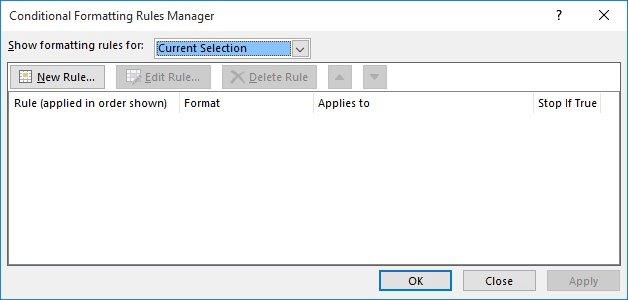Written by Allen Wyatt (last updated February 11, 2023)
This tip applies to Excel 2007, 2010, 2013, 2016, 2019, 2021, and Excel in Microsoft 365
When working with conditional formats, you'll often discover times when you need to apply multiple conditions to a single cell. How you define a single condition is described in other ExcelTips, but Excel allows you to define many conditions that can all apply to the same cell or range of cells.
Begin by selecting the cells for which you want to define conditional formatting rules. Then, with the Home tab of the ribbon displayed, click Conditional Formatting in the Styles group. From the resulting list of options, select Manage Rules. Excel displays the Conditional Formatting Rules Manager. (See Figure 1.)

Figure 1. The Conditional Formatting Rules Manager.
The Conditional Formatting Rules Manager is nothing but a list of the rules which have been defined for the selected cells. Each rule is shown on a separate line, and you can work with the rules by clicking one of the available buttons:
Rules are always evaluated in the order in which they appear in the Conditional Formatting Rules Manager. You can modify the evaluation order by using the up and down arrow tools.
ExcelTips is your source for cost-effective Microsoft Excel training. This tip (6755) applies to Microsoft Excel 2007, 2010, 2013, 2016, 2019, 2021, and Excel in Microsoft 365.

Program Successfully in Excel! This guide will provide you with all the information you need to automate any task in Excel and save time and effort. Learn how to extend Excel's functionality with VBA to create solutions not possible with the standard features. Includes latest information for Excel 2024 and Microsoft 365. Check out Mastering Excel VBA Programming today!
Conditional formatting is a great tool for changing the format of cells based on whether certain conditions (rules) are ...
Discover MoreComparing values (like is done in conditional formatting rules) can yield some crazy results at times. This tip looks at ...
Discover MoreConditional formatting is a great tool you can use to customzie your worksheets. When you want to test whether a value in ...
Discover MoreFREE SERVICE: Get tips like this every week in ExcelTips, a free productivity newsletter. Enter your address and click "Subscribe."
2023-02-11 13:30:50
Tomek
Also important is understanding how the evaluation order really works, and how "Stop if True" setting interacts with the evaluation order.
While the rules are evaluated from top to bottom, it does not mean that the last rule will fully determine how the cell is formatted. If a particular formatting attribute is applied by one rule, any subsequent rule will not change that attribute. For example, if you have a rule setting the background to yellow for value in the cell >5, and the following rule to set the background to red if cell value >10, the cell background will be yellow whether the value is 6 or 100; this cell will never show red background, contrary to what you may expect. To get what you expect, you need to change the order of the rules, and if in doubt, use "Stop if True": the latter, if the condition for that rule is met, will cause the the formatting to ignore all of the rules below.
In short, not as simple as you may think.
Got a version of Excel that uses the ribbon interface (Excel 2007 or later)? This site is for you! If you use an earlier version of Excel, visit our ExcelTips site focusing on the menu interface.
FREE SERVICE: Get tips like this every week in ExcelTips, a free productivity newsletter. Enter your address and click "Subscribe."
Copyright © 2026 Sharon Parq Associates, Inc.
Comments